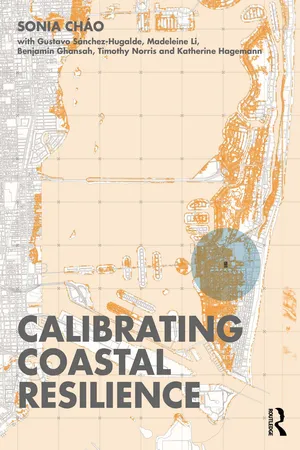
- 336 pages
- English
- ePUB (mobile friendly)
- Available on iOS & Android
Calibrating Coastal Resilience
About this book
Calibrating Coastal Resilience presents a conceptual reimagining of place in the era of climate change. The urban terroir framework introduced by the authors offers a holistic, data-driven approach to assessing vulnerabilities in the built environment and in designing cities. Inspired by the hyperlocal relationships between humans, cultural traditions, and urban and natural contexts, the authors develop a place-based, historically sympathetic methodology for guiding climate-related urban policies, designs, and actions in coastal areas. Coastal communities have been among the first to experience the devastating consequences of the climate crisis. Using case studies from South Florida, the book illustrates the unique climate risks for this region, including flooding, hurricane, and sea-level rise scenarios, with a focus on the preservation of historic neighborhoods and buildings and reinforcement of built structures.
Drawing from the authors' extensive experience in community planning and historic preservation in cities severely affected by the impacts of climate change, this book introduces practical methods for identifying and aligning preservation goals with resilience needs, including a novel and comprehensive methodology that combines their Storm Surge Building Vulnerability (SSVB) additive model with a Synoptic Survey digital method and associated proticols, and a cultural asset benchmarking system that intersects resilience and preservation objectives. Refined through real-life application and the experience of Southeast Florida preparing for and responding to climate change, these techniques are highly specialized yet designed for ease of implementation.
A valuable resource for professionals and students of architecture, urban planning, historic preservation, and local governments globally, Calibrating Coastal Resilience offers communities clear guidelines and actionable steps toward creating place-based resilience planning strategies to safeguard the natural and built landscapes of their region.
Frequently asked questions
- Essential is ideal for learners and professionals who enjoy exploring a wide range of subjects. Access the Essential Library with 800,000+ trusted titles and best-sellers across business, personal growth, and the humanities. Includes unlimited reading time and Standard Read Aloud voice.
- Complete: Perfect for advanced learners and researchers needing full, unrestricted access. Unlock 1.4M+ books across hundreds of subjects, including academic and specialized titles. The Complete Plan also includes advanced features like Premium Read Aloud and Research Assistant.
Please note we cannot support devices running on iOS 13 and Android 7 or earlier. Learn more about using the app.
Information
Table of contents
- Cover
- Half Title
- Title Page
- Copyright Page
- Dedication
- Table of Contents
- Preface
- About the Author
- About the Contributors
- 1 Embracing an Ecological Approach to Urban Design in the Anthropocene Era: Invaluable Lessons from History on the Advantages of Understanding, Evaluating, and Coexisting Harmoniously with Nature
- 2 Multifaceted Challenges and Socioeconomic Considerations
- 3 Addressing the Nature-Culture Dichotomy through Adaptive City Siting and Design in Response to the Emerging Climate Predicament
- 4 Manifesting the “Urban Terroir”: Introducing a Hyper-Local and Holistic Framework for a Climate-Challenged Era
- 5 Re-Mapping Our Future through a Novel Approach: The Urban Terroir Principles, Priorities, Methods, and Tools
- 6 Calibrating Coastal Urban Vulnerabilities and Resilience through Modeling
- 7 The ‘SSBV Synoptic Survey’: Precedents, Climate-Framework, Associated Protocols, and Contributions to the ‘Storm Surge Building Vulnerability Model’
- 8 Development of the Storm Surge Building Vulnerability Model (SSBV): A Hyper-Local Flood Vulnerability Model for Coastal Regions
- 9 The Storm Surge Building Vulnerability Model: Assessing Coastal Morphological and Typological Paradigms through Four Case Studies
- 10 Resolving the Terse Paradox between Historic Preservation and Climate Adaptation: A Proposed Sliding-Scale Benchmarking System
- 11 Effectively Communicating Resilient Affordable Housing and Preservation Alternatives Messages to Community Stakeholders
- 12 The Evolving Role of Governmental Partnerships in Climate Adaptation Planning in the Face of Multiple and Escalating Flood Hazards
- Acknowledgments
- Index